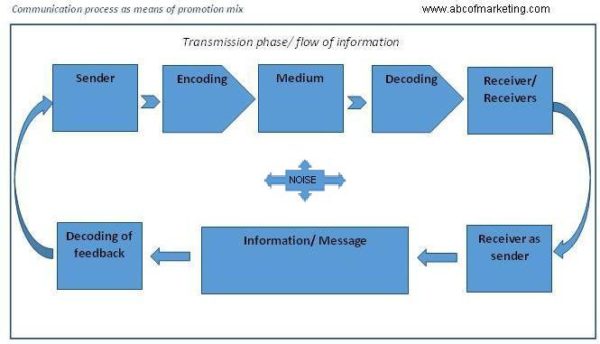Explain the Communication model/ process relative to promotion mix of an organisation.
 Email This Post
Email This Post
In a communication process, the information or message flows between a sender and the receiver.
From the marketing perspective, in the promotion function the information flows between the manufacturer and the audience (end consumers, intermediaries, stake holders, employees, financial institutions like banks, and all the elements which form the target market).
For a marketer, it becomes very critical to understand the elements of the communication process, and how the information flows.
Communication process / Model –
Communication is defined as sharing of information between two or more individuals or groups to reach a common understanding.
Elements of Communication process-
• the sender or communicator is the person/ organisation who initiates a message
• the receiver or interpreter is the person or an organisation to whom a message is directed
• the message (verbal and/or nonverbal content)flows through the channel and must be encoded by the sender and decoded by the receiver
• the medium is the channel by which the message is delivered and received
• the noise is anything that interferes and distorts the message from the sender. Noise is a barrier to effective communication
• feedback is a response from the receiver indicating whether a message has been received as intended
Effective communication holds high importance in marketing strategy when an organisation creates a message and selects a promotion tool to reach the receiver (middlemen, customers, stake holders, etc.). Similarly, an organisation has to organise a proper system to ensure the feedback from the receivers is received as they have intended. Only when the feedback is received and interpreted at the senders end, the communication process is said to be complete.
A marketer needs to make decisions at every step of the communication process.
For the communication process to be effective, the sender’s encoded message should match the decoding process of the receiver. It becomes very important for the organisation to study its target audience to send across an effective message using the right medium.
1) The sender of the message is the company which intends to send a message to the audience. Encoding is the process where a thought or idea is converted into a message by way of texts and symbols.
2) The message layout which includes arrangement of texts and visual displays should create favourable customer impression, capture their attention and convey the message. An incomplete message or an unclear message will not serve its purpose because the receiver will fail to decode or interpret it.
A message is used to perform three functions – share information, persuade, or remind. Almost all messages include the organisations name, product name and features, its advantages and attributes.
3) Decoding is referred to the way a receiver interprets the message. The decoding relies on the audience’s capability and clarity of the message. An advertisement for a smartphone will have a different effect on a youngster as compared to a senior citizen.
4) The audience can be the end customers, stock holders, media, middlemen, etc. The organisation needs to have a clarity on the target customer’s characteristics, demography, life style and behaviour. The target audience not only grasp and seek information from the source but also from the people around them like friends and family members. This is known as word-of-mouth in which information if passed from person to person either verbally or any other media like text message, internet, etc. Marketers should ensure that the customers are satisfied to overcome negative word-of-mouth communication. To enforce positive word-of-mouth among audiences, marketers usually take help of celebrities endorsing the product, sharing testimonials or reviews of satisfied customers.
5) Feedback refers to the response of the audience in the target market. The most valuable feedback for an organisation is customers buying the product, and there is an increase in sales. However, to ensure the company increases its market share, it should give opportunities to the buyers to share their inputs. The audience may share their feedback in a way they want. It can be as simple as not buying the product or a detailed feedback on not understanding the message. The organisation has to encode the message and make improvements for more effective message and effective media.
6) Noise interferes and distorts the message from the sender. This affects the message at any stage of the process. For example,
• a marketer working on a message may not be mentally present at work,
• a marketer may be getting constant interruptions from others at work while working on a message,
• a receiver while watching an advertisement may get a phone call,
• a receiver may overlook an email communication,
• a receiver may miss a marketing call,
• a sales man not fully aware about the features of the product he is selling,
• interruptions from the customer while making a demo, etc.
Marketing managers have to constantly look out for threats that may cause miscomprehension of the message. Marketers send the message regularly for a certain period to ensure the receivers who have missed receiving the message are kept updated and reminded about the information.
Effective communication or “complete communication process” takes place when a sender’s message is fully understood by the receiver.

